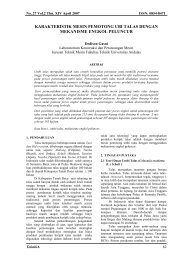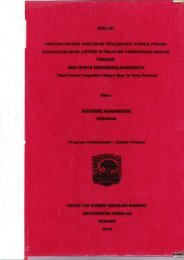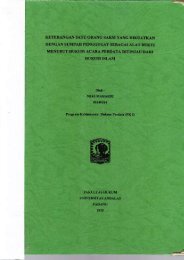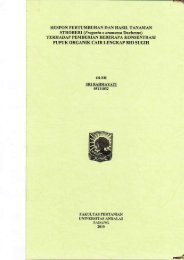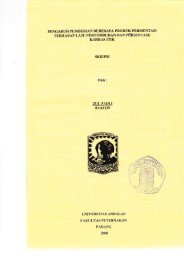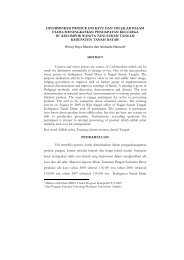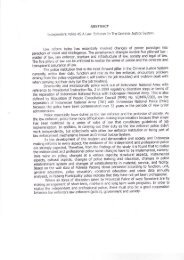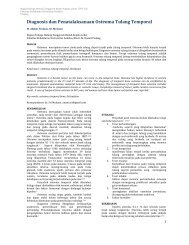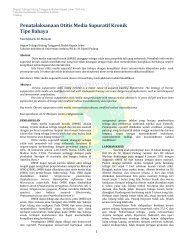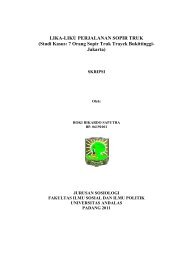FISIOLOGI REPRODUKSI - Repository Universitas Andalas
FISIOLOGI REPRODUKSI - Repository Universitas Andalas
FISIOLOGI REPRODUKSI - Repository Universitas Andalas
You also want an ePaper? Increase the reach of your titles
YUMPU automatically turns print PDFs into web optimized ePapers that Google loves.
<strong>FISIOLOGI</strong><br />
<strong>REPRODUKSI</strong><br />
Rahmatina B. Herman<br />
Bagian Fisiologi<br />
Fakultas Kedokteran <strong>Universitas</strong> <strong>Andalas</strong>
Reproduction<br />
Reproduction is process to maintain<br />
continuation of species by which<br />
- new individuals of a species are produced<br />
- genetic material is passed from generation<br />
to generation<br />
Cell division in a multicellular organism is<br />
necessary for growth and it involves passing of<br />
genetic material from parent cells to daughter<br />
cells<br />
Performed by reproductive system
The Reproductive System<br />
This system does not contribute to homeostasis<br />
Is not essential for survival of an individual<br />
But still plays an important in a person’s life,<br />
e.g. the manner:<br />
- in which people relate as sexual beings<br />
contributes in significant ways to<br />
psychosocial behavior<br />
- how people view themselves<br />
- how people interact with others
…..The Reproductive System<br />
Reproductive function also has a profound<br />
effect on society:<br />
- universal organization of societies into family<br />
units provide a stable environment that is<br />
conducive for perpetuating our species<br />
- on other hand, population explosion and its<br />
resultant drain on dwindling resources<br />
have led to worldwide concern with means<br />
by which reproduction can be limited
…..The Reproductive System<br />
Reproductive capability depends on intricate<br />
relationship among hypothalamus, anterior<br />
pituitary, reproductive organs, and target cells<br />
of sex hormones<br />
These relationship employ many of regulatory<br />
mechanisms used by other body systems for<br />
maintaining homeostasis, such as negativefeedback<br />
control
…..The Reproductive System<br />
The organ of male and female may be grouped by<br />
function<br />
Testes and ovaries (called gonads), function in<br />
production of gametes: sperm cells and ova<br />
Gonads also secrete hormones<br />
The ducts of reproductive systems transport, receive,<br />
and store gametes<br />
Accessory sex glands produce materials that support<br />
gametes<br />
In females, the breasts are also considered accessory<br />
reproductive organs<br />
The externally visible portions of reproductive system<br />
are known as external genitalia
Secondary Sexual Characteristic<br />
Secondary sexual characteristic (SSC) are many<br />
external characteristics not directly involved in<br />
reproduction<br />
That distinguish male and female<br />
Development and maintenance governed by<br />
testosterone in males and estrogen in females<br />
Progesterone has no influence on SSC<br />
Axillary and pubic hair growth is not SSC
…..Secondary Sexual Characteristic<br />
In some species, secondary sexual<br />
characteristic are great importance in courting<br />
and mating behavior (e.g. to attract female’s<br />
attention)<br />
In humans, attraction the opposite sex not<br />
only influenced by secondary sexual<br />
characteristic but also strongly affected by the<br />
complexities of human society and cultural<br />
behavior
Sex Determination and Differentiation<br />
Reproductive cells each contain a half set of<br />
chromosomes<br />
Gametogenesis is accomplished by meiosis<br />
The sex of and individual is determined by<br />
combination of sex chromosomes<br />
Sexual differentiation along male or female<br />
lines depends on the presence/ absence of<br />
masculinizing determinant
Parents with diploid (46 chr) somatic cells<br />
Mother Father<br />
Meiotic division<br />
of germ cells<br />
Meiotic division<br />
of germ cells<br />
Haploid Ovum Haploid Sperm<br />
Fertilization<br />
Diploid fertilized Ovum<br />
Mitosis<br />
Offspring of diploid somatic cells
Ovum with X sex chromosome<br />
Fertilized by<br />
Sperm with Y sc Sperm with X sc<br />
Embryo with XY sc Genetic sex Embryo with XX sc<br />
Sex-determining region<br />
of Y chr (SRY) stimulates<br />
Production of H-Y antigen<br />
In plasma membrane of<br />
undifferentiated gonad<br />
H-Y antigen directs<br />
differentiation<br />
of gonads into testes<br />
Gonadal<br />
sex<br />
No Y chr, so no SRY<br />
and no H-Y antigen<br />
With no H-Y antigen,<br />
undifferentiated gonads<br />
develop into ovaries
Testosterone<br />
Converted to<br />
Dihydrotestosterone<br />
Testes secrete hormone and factor<br />
Promotes development of<br />
undifferentiated external<br />
genitalia along male lines<br />
(e.g. penis, scrotum)<br />
Phenotype<br />
sex<br />
Mullerian-inhibiting factor<br />
Degeneration of<br />
Mullerian ducts<br />
Transforms Wolfian ducts<br />
into male reproductive tract<br />
(e.g. epididymis, ductus<br />
deferens, ejaculatory duct,<br />
seminal vesicle)
Ovaries does not secrete hormone and factor<br />
Absence of testosterone<br />
Undifferentiated external<br />
genitalia along female lines<br />
(e.g. clitoris. labia)<br />
Degeneration of<br />
Wolfian ducts<br />
Phenotype<br />
sex<br />
Absence of Mullerian-<br />
inhibiting factor<br />
Mullerian ducts develop<br />
Into female reproductive<br />
tract (e.g. oviducts, uterus)
<strong>FISIOLOGI</strong><br />
<strong>REPRODUKSI</strong> PRIA
Reproductive Functions of Male<br />
The essential reproductive functions of male are:<br />
1. Production of sperm (spermatogenesis) by<br />
testes (in skin-covered sac: scrotum)<br />
2. Delivery of sperm to female – semen by<br />
- male reproductive tract: epididymis, vas<br />
deferens, ejaculatory duct<br />
- urethra (in penis)<br />
3. Male accessory sex glands: providing bulk of<br />
semen: seminal vesicle, prostate,<br />
bulbourethral gland
Testes<br />
Primary male reproductive organs<br />
Perform dual function:<br />
- producing sperm (spermatogenesis)<br />
- secreting male sex hormone: testosterone<br />
Scrotal location provides a cooler environment<br />
essential for spermatogenesis<br />
Position of scrotum in relation to abdominal<br />
cavity can be varied by spinal reflex mechanism<br />
that plays important role in regulating<br />
temperature
Development of Testes<br />
In male embryo, testes develop from the genital ridge<br />
located at the rear of abdominal cavity<br />
In last months of fetal life, testes begin a slow descent,<br />
passing out of abdominal cavity through inguinal canal<br />
into scrotum which is induced by testosterone<br />
After testes descend into scrotum, the opening of<br />
abdominal wall through which inguinal canal passes<br />
closes snugly around sperm-carrying duct<br />
Incomplete closure or rupture of this opening permits<br />
abdominal viscera to slip through resulting inguinal<br />
hernia
Functioning of Testis<br />
During fetal life:<br />
- stimulated by chorionic gonadotropin (hCG)<br />
A few weeks after birth until puberty<br />
(prepubertal period / childhood):<br />
- dormant<br />
Productive period:<br />
- stimulated by gonadotropic hormone (GnH)<br />
- Spermatogenesis usually continues until death<br />
Male climacteric:<br />
- Decrease testosterone secretion<br />
- Decreasing sexual function
Ductal System<br />
Ductus epididymis<br />
- Loosely attached to the rear surface of each testes<br />
- Sperm from seminiferous tubules are swept into<br />
epididymis as a result of pressure created by continual<br />
secretion tubular fluid by Sertoli cells<br />
Ductus (vas) deferens<br />
- Formed from converged of epididymal ducts<br />
- Thick-walled, muscular duct<br />
- Ductus deferens from each testes passes up out of scrotal<br />
sac and runs back through inguinal canal into abdominal<br />
cavity, where it eventually empties into urethra at neck<br />
of bladder
Accessory Sex Glands<br />
Seminal vesicles:<br />
- Empty secretions into the last portion of ductus deferens<br />
- Supply fructose to nourish the ejaculated sperm<br />
- Secrete prostaglandin for sperm motility to help transport<br />
- Provide precursors for clotting of semen (fibrinogen)<br />
Prostate gland:<br />
- Completely surrounds urethra at bladder neck<br />
- Secretes alkaline fluid<br />
- Provides clotting enzymes and fibrinolysin<br />
Bulbourethral glands:<br />
- Empty secretions into urethra just before urethra enters<br />
penis
Tubuli seminiferi<br />
Spermatogenesis<br />
During active sexual life<br />
As the result of stimulation by anterior<br />
pituitary gonadotropic hormones<br />
Beginning at age of ± 13 ys<br />
Continuing throughout the remainder of life
Steps of Spermatogenesis<br />
…..Spermatogenesis<br />
1. Mitosis: spermatogonia A spermatogonia B<br />
2. Enlargement: primary spermatocyte<br />
3. Meiosis:<br />
I. Primary spermatocyte secondary spermatocyte<br />
II. Secondary spermatocyte early spermatid<br />
4. Physically reshaping: spermiogenesis<br />
Early spermatid late spermatid spermatozoon 23<br />
pairs of chromosomes
…..Spermatogenesis
Hormonal Control of Testes Function
Motile<br />
Fertile<br />
Sperms<br />
(Normal and Mature)<br />
Movement: 1 – 4 mm/min.<br />
Travel in a straight line<br />
Activity: enhanced in neutral and slightly alkaline,<br />
depressed in mildly acidic media<br />
Rapid death in strong acidic media<br />
Temperature activity metabolism rate <br />
shortened life<br />
Live: - many weeks in genital ducts of testes<br />
- 1 - 2 days in female genital tract
Semen<br />
Fluid: - vas deferens (10 %)<br />
- vesicula seminalis (60 %)<br />
- prostat (30 %)<br />
- mucous glands (bulbourethral)<br />
pH: ± 7.5<br />
Mucoid and milky<br />
Weak coagulum dissolve in 15 – 30 minutes<br />
May be stored for years in - 100°C
<strong>FISIOLOGI</strong><br />
<strong>REPRODUKSI</strong> WANITA
Reproductive Functions of Female<br />
Female’s role in reproduction is more complicated:<br />
1. Production of ova (oogenesis) by ovaries<br />
2. Reception of sperm: vagina-cervix<br />
3. Reception of sperm and ovum to a common site for<br />
union (fertilization or conception): Fallopian tube<br />
4. Maintenance of the developing fetus until it can<br />
survive in outside world (gestation or pregnancy),<br />
including formation of placenta: uterus<br />
5. Giving birth to the baby (parturition)<br />
6. Nourishing the infant after birth by milk production<br />
(lactation): mammae
Ovaries<br />
Primary female reproductive organs<br />
Perform dual function:<br />
- producing ova (oogenesis)<br />
- secreting female sex hormones:<br />
estrogen and progesterone which act together to:<br />
> promote fertilization of ovum<br />
> prepare female reproductive system for pregnancy<br />
Homologous to testes (in structure, position,<br />
and origin)<br />
Descend to brim of pelvis during third month of<br />
development
Development of Ovaries<br />
During fetal life, the outer surface of ovary is<br />
covered by germinal epithelium<br />
Cells that give rise to ova arise from endoderm<br />
of yolk sac and migrate to ovaries during<br />
embryonic development at 5-6 weeks of<br />
gestation<br />
Primordial (primitive) germ cells migrate from<br />
endoderm of the yolk sac to ovaries during<br />
early fetal development
Functioning of Ovaries<br />
During fetal life:<br />
- stimulated by chorionic gonadotropin (hCG)<br />
A few weeks after birth until puberty<br />
(prepubertal period / childhood):<br />
- dormant<br />
Productive period:<br />
- stimulated by gonadotropic hormone (GnH)<br />
and ovarian hormone<br />
Menopause
Components of Female Reproductive Tract<br />
Oviducts (Fallopian tubes)<br />
- in close association with ovaries,<br />
- pick up ova on ovulation and serve as fertilization site<br />
Uterus<br />
thick-walled hollow: responsible for<br />
- maintaining fetus during development<br />
- expelling it at the end of pregnancy<br />
Cervix<br />
- lowest portion of uterus<br />
- projects into vagina<br />
Cervical canal<br />
pathway for sperm and passageway for baby delivery
…..Components of Female Reproductive Tract<br />
Vagina<br />
expandable tube, connects uterus to external environment<br />
Vaginal opening<br />
located in perineal region between urethral and anal<br />
opening<br />
Hymen<br />
thin mucus membrane partially covering vaginal opening<br />
Labia minora and labia majora<br />
skin folds surrounding vaginal and urethral openings<br />
Clitoris<br />
Female external genitalia collectively: vulva
Oogenesis<br />
In the 3 rd month of prenatal development: oogonia<br />
divided mitotically into primary oocytes (diploid/ 2n)<br />
until 20-24 weeks 7 million (maximum)<br />
7 month after conception, fetal oogonia cease dividing<br />
From this point on no new germ cells are generated<br />
Almost from the start, attrition process occurs:<br />
- by birth only 2 million primary oocytes remain<br />
- by puberty: 300.000 - 400.000<br />
- during active sexual life: 400 expelled ova<br />
- at or soon after menopause: few (if any)
…..Oogenesis<br />
Primary oocytes enter reduction division (meiosis I),<br />
but do not complete the division in the fetus<br />
Cells are said to be in a state meiotic arrest, and this<br />
state continues until puberty<br />
Only primary oocytes destined for ovulation will ever<br />
complete the first meiotic division, for it occurs just<br />
before the egg is ovulated<br />
The second meiotic division occurs in a fallopian tube<br />
after ovulation, but only if the secondary oocyte is<br />
penetrated by a sperm (fertilized )<br />
Daughter cell receive 23 chromosomes (haploid/ n)<br />
Each primary oocyte can produce only one ovum
…..Oogenesis
Hormonal Control of Ovarian Function<br />
Primarily FSH<br />
Granulosa<br />
Cells<br />
Inhibin<br />
Hypothalamus<br />
GnRH<br />
Anterior Pituitary<br />
FSH and LH<br />
FSH LH<br />
Estrogen<br />
Estrogen<br />
Theca<br />
Cells<br />
Androgen<br />
Ovaries
Female Monthly Rhythm<br />
Cycle: 28 days (20 – 45 days)<br />
Ovarian cycle<br />
1. The follicular phase: - ovarian follicle growth<br />
- ovulation<br />
2. The luteal phase: development of corpus luteum<br />
Endometrial cycle (Uterine cycle)<br />
1. Proliferative phase: - estrogen phase<br />
- before ovulation<br />
2. Secretory phase: - progestational phase<br />
- after ovulation<br />
3. Menstruation
…..Female Monthly Rhythm
Ovarian Cycle
Endometrial Cycle



